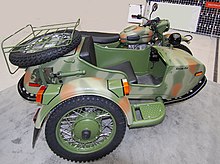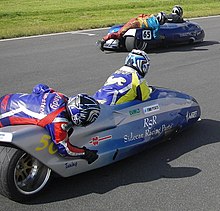Sidecar: Difference between revisions
Tag: possible conflict of interest |
|||
| Line 63: | Line 63: | ||
==External links== |
==External links== |
||
* [http://www.jawaireland.ie/sidecar_dealer_15.html/ www.jawaireland.ie] (Velorex Sidecars) |
|||
{{commonscat|Sidecars}} |
{{commonscat|Sidecars}} |
||
Revision as of 22:57, 3 June 2009


A sidecar is a one-wheeled device attached to the side of a motorcycle, producing a three-wheeled vehicle. Early sidecars were intended to be removable devices that could be detached from the motorcycle. The first mention of a sidecar is in a cartoon by George Moore in the January 7, 1903 issue of the British newspaper "Motor Cycling". Three weeks later a provisional patent was granted to Mr. W. J. Graham of Graham Brothers, Enfield, Middlesex. A motorcycle with a sidecar is sometimes called a combination, an outfit, a rig or a hack.
Structure
A sidecar motorcycle is a three wheel vehicle with the sidewheel not directly aligned with the rear motorcycle wheel, and is usually powered by the rear wheel only. This is different from a motorcycle trike, where both rear wheels are powered and share a common axle. However, either P.V. Mokharov of the Soviet Union or H.P Baughn of Great Britain seem to have to been the first to employ a driven sidecar wheel in 1929. In fact Baughn 2WD outfits were so successful in trials events in the early 1930s that there were attempts to have the ACU ban them from competition. A great many companies experimented with 2WD in sporting events and indeed many companies employed them in military vehicles prior to the commencement of WWII.
The sidecar consists of a frame (which is rigidly fixed to the motorcycle's frame on one side and is supported by the sidecar's wheel on the other side) and of a body. The body typically provides one passenger seat and a small trunk compartment behind. In some case the sidecar has a removable soft top. In some modifications the sidecar's body is used for carrying cargo or tools (like a truck's platform).
A sidecar completely changes the geometry of a motorcycle, which then must be steered like a car, rather than countersteered. If the sidecar is not attached properly it will make the motorcycle unstable.
History

Sidecars have been manufactured since early in the twentieth century. Until the 1950s sidecars were quite popular, providing a cheap alternative to passenger cars; they have also been used by armed forces, police and the UK's AA and RAC motoring organisations. During WWII, German troops used many BMW and Zündapp sidecar motorcycles. On German, French, Belgian, British and Soviet military sidecars, the side wheel was sometimes also driven, sometimes using a differential gear, to improve the vehicle's all-terrain ability.
One of Britain's oldest sidecar manufacturers, Watsonian, was founded in 1912. It is still trading as Watsonian-Squire.[1] Jaguar Cars was founded in 1922 as a sidecar manufacturer, the Swallow Sidecar Company.
Regulation
In Taiwan, Article 39-2 of the Road Traffic Security Rules (zh:道路交通安全規則) prohibits motorcycles from attaching sidecars when applying for registrations. These Rules do not specify the use of sidecars thereafter.
In Australia and the U.K., (both right-hand drive countries), right hand sidecars are prohibited.
Manufacturers
Although sidecars have become much less common since the mid 1950's, a number of manufacturers worldwide have continued to produce sidecars for many popular motorcycles and scooters. Active sidecar manufacturing companies include:
- Velorexport (manufacturer of Velorex Sidecars in Czech Republic)
- Hongdu and Zhuzhou in China
- Watsonian-Squire in England
- Cozy in India
- IMZ-Ural and VMZ for Izh in Russia
- Harley-Davidson in the USA
- Dnepr in Ukraine (ceased manufacture in 2007)
- Highway Sidecars (HRD, DJP and Higgins) and Premier in Australia
- Louis Christen Racing in Switzerland
- GG Duetto in Switzerland
Sport


Sidecar racing events exist in Motocross (see Sidecarcross), Enduro, Grasstrack, Trial and road racing with sidecar classes. The sport has followers in Europe, United States, Japan, Australia and New Zealand. The sidecars are often classed by age or engine size, with historic sidecar racing often being more popular than its modern counterpart. Older classes in road racing generally resemble solo motorcycles with a platform attached, where modern racing sidecars are low and long and borrow much technology from open wheel race cars. In all types of sidecar racing there is a rider and a passenger who work in unison to make the machine perform, as they would be almost unrideable without the passenger in the correct position.
Road racing sidecars began to change away from normal motorcycle development in the 1950s with them becoming lower and using smaller diameter wheels and they kept the enclosed "dustbin fairing" banned in solo competition in 1957. By the 1970s they were using wide slick tyres with a square car like profile, the rider kneeled behind the engine instead of sitting on a seat and the motor of choice was generally a 500 cc two stroke. In the late 1970s sidecars began to appear with hub centre steering and later the engines moved to the rear of the rider, to lower the centre of gravity further still, making the sidecar very long. Sidecars raced in the world championship known as Superside are all hub centre long monocoque framed machines, the most common being LCR, ART or Windle, with 1000 cc four cylinder four stroke engines, the most popular being the Suzuki GSX-R1000.


These at club and national level are known as Formula One sidecars, as opposed to Formula Two. Formula Two sidecars comprise of short front engined bikes, which must have a frame made of steel tube and have leading link forks as monocoques and hub centre steering is banned. Engines are 350 cc two strokes or 600 cc four strokes. F2 sidecars are raced in their own championship but are often on track at the same time as the F1s, but competing for their own points. Since 1987 at the Isle of Man TT, the Sidecar TT has been solely contested by Formula Two sidecars as Formula Ones were deemed too fast, then lapping at 108 mph (174 km/h) average. By 2006 however F2s were faster than this lapping at 116 mph (187 km/h).
A Squire sidecar attached to a Triumph TR65 Thunderbird albeit one factory-fitted with the electronic ignition and electric starter options and after-market Hedingham leading link front forks carried Richard and Mopsa English around the world from 1982 to 1986. The journey is detailed in their book, Full Circle.
See also
External links
- www.jawaireland.ie (Velorex Sidecars)
